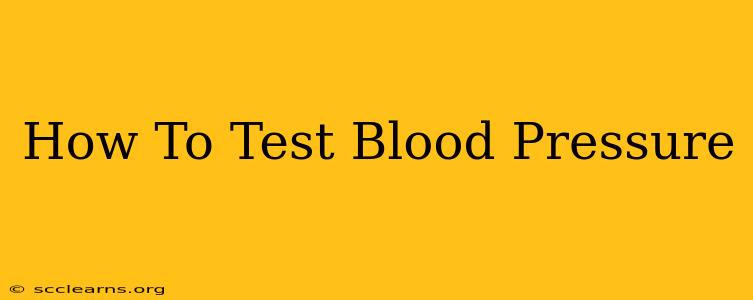Knowing how to test your blood pressure correctly is crucial for managing your health. High blood pressure (hypertension), often called the "silent killer," can lead to serious health problems if left untreated. While regular checkups with your doctor are essential, learning to monitor your blood pressure at home empowers you to take control of your well-being. This guide provides a step-by-step approach to accurate blood pressure testing.
Understanding Blood Pressure Readings
Before we delve into the how-to, let's understand what a blood pressure reading means. Your blood pressure is expressed as two numbers:
- Systolic Pressure: The top number, representing the pressure in your arteries when your heart beats.
- Diastolic Pressure: The bottom number, representing the pressure in your arteries when your heart rests between beats.
Both numbers are measured in millimeters of mercury (mmHg). For example, a reading of 120/80 mmHg is considered normal. Readings consistently above 140/90 mmHg are generally considered high blood pressure. However, it's crucial to consult your doctor for personalized advice based on your individual health history and risk factors.
Equipment Needed for Accurate Blood Pressure Measurement
To accurately test your blood pressure at home, you'll need a reliable blood pressure monitor. There are two main types:
- Manual Blood Pressure Monitor: Requires a stethoscope and sphygmomanometer (the inflatable cuff). This method necessitates training and practice to obtain accurate readings. It's generally recommended that a healthcare professional demonstrate proper use before you attempt it independently.
- Automatic Blood Pressure Monitor: These monitors are easier to use. They automatically inflate the cuff and display the systolic and diastolic readings digitally. This type is generally more convenient for home use.
Choose a monitor that has received positive reviews and is validated for accuracy. Look for features like large, easy-to-read displays, and clear instructions.
Step-by-Step Guide to Testing Your Blood Pressure
Regardless of whether you use an automatic or manual monitor, follow these steps for the most accurate readings:
1. Preparation is Key
- Rest: Sit quietly for at least 5 minutes before taking your reading. Avoid strenuous activity or caffeine immediately beforehand.
- Proper Posture: Sit with your back supported and your feet flat on the floor. Your arm should be supported at heart level.
- Avoid Talking: Talking during the measurement can affect the reading.
- Clothing: Ensure your upper arm is bare or that clothing isn't constricting the cuff.
2. Positioning the Cuff
- Correct Placement: The cuff should be placed snugly around your upper arm, about 1 inch above your elbow, ensuring it's not too tight or too loose. The artery should be centered under the cuff.
3. Using Your Monitor
- Automatic Monitor: Follow the manufacturer's instructions to start the reading. The device will inflate the cuff and display the results. Take several readings, spaced a few minutes apart, and average them.
- Manual Monitor: This method requires proper training from a healthcare professional. It involves listening for heart sounds through a stethoscope as you manually inflate and deflate the cuff.
4. Recording Your Readings
- Consistent Time: Take your blood pressure at the same time each day for consistent results.
- Documentation: Keep a record of your readings, including the date, time, and both systolic and diastolic numbers. Share this information with your doctor during your next appointment.
Interpreting Your Readings and When to Seek Medical Attention
After taking your blood pressure, consult your doctor to understand what your readings mean. They can advise you on your blood pressure goals and any necessary lifestyle changes or medication.
Seek immediate medical attention if you experience:
- Severely elevated blood pressure: Readings consistently above 180/120 mmHg.
- Sudden severe headache: Particularly accompanied by other symptoms like nausea, vomiting, or vision changes.
- Shortness of breath: Difficulty breathing, especially if accompanied by chest pain.
Lifestyle Changes to Manage Blood Pressure
Regularly monitoring your blood pressure is crucial. In addition to monitoring, you can also consider making lifestyle changes to help manage your blood pressure. These include:
- Regular Exercise: Aim for at least 150 minutes of moderate-intensity aerobic activity per week.
- Healthy Diet: Focus on a diet rich in fruits, vegetables, whole grains, and lean protein. Reduce sodium intake.
- Weight Management: Maintain a healthy weight to reduce strain on your heart and blood vessels.
- Stress Reduction: Practice relaxation techniques like yoga or meditation to manage stress levels.
- Limit Alcohol: Moderate or avoid alcohol consumption.
Regular blood pressure monitoring combined with healthy lifestyle choices is key to maintaining good cardiovascular health. Remember, this information is for educational purposes only and should not replace professional medical advice. Always consult your doctor for personalized guidance regarding your blood pressure management.

